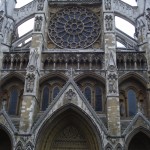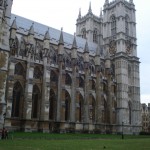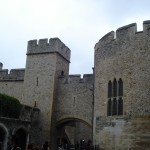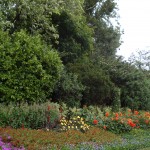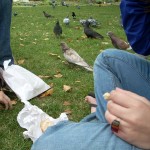After an early breakfast at the Arran House and a short walk through a light mist back to Trafalgar Square I had a chance to cross some more major sites off my list today. The first of these was Westminster Abbey. The entire class was taken on a thorough tour of the Abbey by John, a knowledgeable, excitable man who made the tour a captivating experience throughout despite the fact that my feet were aching terribly by the end of the two hour experience. Prior to the tour starting I spent a few minutes gazing at the magnificent building from the outside and found myself immediately in awe by both the innate architecture and simply the sheer size of the building. This feeling increased tenfold once we entered. After walking past the courtyard we entered into the nave where I was once again impressed by the beautiful architecture. The tour consisted of a little bit of everything including the tombs of past monarchs, the Grave of the Unknown Warrior and a section dedicated entirely to writers of England. All of these sites caught my attention and stuck with me but my favorite part of the Abbey by far was The Lady Chapel. The many Saints delicately carved into the sides of the room was miraculous. Each one was designed so intricately that even the smallest features were easily discernible. The thing that fascinated me the most inside The Lady Chapel was the Order of the Bath. Each knight in the Order had their own individual flag and seal which they displayed prominently over their seat. Each and every flag was unique and told a different story about the individual that they represent. I found it interesting that knights are sometimes forced to wait a number of years to have their flags displayed because they are required to wait until the person who holds the spot before them passes away before their spot is opened up. After walking through The Lady Chapel I had a sudden urge to design my own flag and copper stall-plate and maybe even start my own Order of the Bath. We will see…
After a pub lunch at the Red Lion, located just a few minutes from the Abbey, Alli, Becca, Chelsea, Kim, Mara, Sarah and I headed to the Tower of London. Heading in with “great expectations” I have to say I was a bit disappointed overall. It was interesting to walk through the ancient monument but I had no idea it would draw the massive number of tourists it did. All ages were represented but I was very surprised to see a large amount of young children walking through the tower, a number of them unaccompanied by adults. The highlight of the Tower of London experience was the Crown Jewel exhibit. After being instructed to put our cameras away we were taken into a room with pressurized doors where we examined crowns that monarchs wore. In addition to the crowns we saw diamond laden rings, sceptors and golden cutlery that made our jaws drop. The most amazing object I observed was a giant punch bowl made entirely out of gold and must have weighed over 18 kilograms. Completely and utterly unbelievable! After the Crown Jewels exhibit my time at the tower went South. Due to the amount of loud, rambunctious children present and a subpar exhibit on torture in the Tower we walked through I was ready to leave after about two hours. Overall my experience was not a completely negative one. Being inside the grounds was breathtaking and the architecture amazed me. However I do not see myself returning here during the rest of my time in London.
After our time in the Tower Alli, Kim, Mara, Sarah and I decided to get an early start on our walking tour project. Since our general theme is parks in London we decided it would be a good idea to visit a couple of the major green spaces in the area. We hopped on the tube and took the central line to St. James Park station. Upon arrival we spent some time moseying around Buckingham Palace and Victoria’s Memorial before getting down to business and taking a stroll through Green and St. James Park. Nothing too exciting was going on at Green Park. At one point we sat down in light green lawn chairs only to be told that we had to pay a fee in order to sit. We quickly dismissed Green Park as a space that we would focus our project on. St. James however was a different story. We immediately spotted water and wandered over where we discovered a multitude of birds including ducks, geese and pigeons. These birds were not afraid to come close to humans at all and we saw many eating out of the hands of children who were offering them bread despite the numerous signs that clearly read “don’t feed the birds”. We wandered through most of the park, passing beautiful lush flower gardens along the way. Overall St. James seemed more alive then Green Park and we definitely plan on heading back to take another look when the Park Office is open and we can receive more information about it’s history.
Today was a very rewarding day overall. I am happy to say that I was able to visit some of the most historic places in the country in one day and ecstatic that my experience at Westminster Abbey went so positively. I’m amazed at just how much I have been able to see in one week here and I know that I continue to see more and more incredible places during my time here in London. Next up: Stonehenge!
Tags: Churches and Cathedrals · Henry
The man who spoke these words has been criticized, revered, idolized, and forever memorialized in Britain and throughout the world. His contributions (and faults) are integral to history books and will remain as such so long as people study the twentieth century in any capacity. This man was Winston Churchill. His life and legacy, traced by the recently opened Churchill Museum (located in the equally significant Cabinet War Rooms), was one among many stops on today’s venture out to the city.
What a fascinating life this man led. Certainly, many know him as the Prime Minister who essentially led Britain through WWII. The years of his (first) term in office were some of his finest and most recognized moments. I’ve studied Churchill before stepping foot in the Museum (If you haven’t seen it, you must go – it’s worth every pence) and knew that he led an illustrious career in the British government throughout the early 1900s. Throughout his life he wrote books and articles, he painted, and he traveled. He went on to serve as Prime Minister once more in the 1950s but soon retired due to his declining health. The life he led was unconventional but provocative enough to grab the spotlight as one of the most influential leaders of the last century. I certainly agree with Kelley (“All Around Westminster”) that all politicians have their faults and not-so-proud moments, and Churchill is no exception. I do not and will not idolize Churchill, but, admittedly, just his persona alone demands your attention.

"Cheer up! They will forget _you_ but they will remember _me_ always."
This museum, attached to the Cabinet War Rooms, gave such a profound impression of life for government officials during the Second World War. Moreover, if Winston Churchill had to crawl through these narrow halls for meetings underground during bomb raids, one can’t even imagine what it was like to be stuck above ground (or at least above the thick slab of concrete and steel that guarded the War Rooms). As a student endlessly fascinated by culture, politics, and leadership of Britain, Europe, and the United States (few among a growing list) during the twentieth century, this museum gave me some new perspective on Britain during the war.
I feel I would be doing the Westminster Abbey and St. James Park some injustice if I failed to mention how astounded I was when I saw them. The architecture of the Abbey and the awe-inspiring space it occupies could make anyone feel small and insignificant. The tombs and busts of individuals line every wall and, to add some eerie sense to the building, every walkway. The eroded stone of tombstones embedded in the floor felt sacrilegious; take, for instance, standing on the grave of Charles Dickens, which felt powerful and odd at the same time. The hundreds of people in the Abbey had headsets stuck to their ear, which, at the time made sense. After some reflection, one could have wandered without tour guides or headsets and have had a similarly profound experience.
St. James, too, had some remarkable qualities. The most striking is it’s sheer size. A pond cuts through the middle of the park and stretches far into the distance. At one point, you couldn’t hear or see anything but the park. The people, too, add an interesting flavor to the area. No one sat in the hundreds of chairs in the space (and rightfully so – you must pay to sit down in the chairs, apparently), so they opted for lying down in the grass. Some were loud businesspeople eating their lunch, some were on a run, and others seemed dazed and confused as they wandered. It definitely attracts a variety of people, but, as already noted below in Audrey’s post “Peace out from the park,” the open gates of the park may be limiting other people given its location, among other reasons.



How did we possibly manage to fit all of this in one day?
Tags: Brandon
After the highly informative Westminster Abbey tour, we decided to economize and out outside rather than pay extra to sit in. Unfortunately, we decided on the wrong park. Completely unbeknownst to us unwitting Americans, the British government is not content with simply extorting us at restuarants. Instead, they have decided to charge individuals for the “right” to sit in lawn chairs in the parks surrounding London. Though to be fair, we do not know if this is entirely true because this incident just occured at the wonderful St. James’ Park. While asthetically pleasing, the man walking around with a pence machine was very disconcerting. Being the crass Americans we are, instead of paying this man representing the greedy British government, we resevered our right to sit freely on the grass (despite his several attempts to swindle us). After suggesting that this incident reminded us of the rediciously “tea tax” placed on British imports to America in the 18th Century, we considered throwing our lawn chairs in the River Thames just to prove a point. Though after careful consideration and debate, we decided against this plan of action.
Instead, we rebelled by giving the local pigeon population the remains of our lunches. To our shock, we were unexpectedly surrounded but what seemed to be the entire pigeon population of London. Nevertheless, this did not deter us. Upon luring this savage creatures as close as possible and feeding them scrapes of bread, Amy decided to charge through the mass of beasts only to have one nearly miss Maddy and promoting the other people around us to duck for cover. With the pigeons well fed, the rebellion spread to some British children. We can only hope this incident will spark civil war among the park goers of London.
These are just a few differences between the American and British way of life.
Tags: Andrew F · Campbell
St. James’ Park is incredibly beautiful. This shouldn’t come as a surprise as absolutely every park if not every tourist attraction in London could be classified in this way. Entering right across from the Cabinet Warrooms, I instantly spotted my next home. The most picturesque cottage sits on the edge of the park- one for which I instantly began planning wallpaper schemes. That’s the feeling you get at St. James’ Park though; that is, a feeling of being at home (or at least wanting it to be your home). Past the cottage, a garden of perfection leads you towards a pond that is as lovely as everything else surrounding it. Parks like these always make me grateful of those that decide to give the people of a busy city a place to go to escape the hustle, bustle, and overpriced world that engulfs them everyday to a place of peace and tranquility. Truly, St. James’ Park accomplishes that in a spot on fashion.

St. James' Park
Still, something doesn’t quite feel right in saying that all Londoners enjoy peace at St. James’ Park or in saying that the park succeeds in offering peace to everyone in the city. A quick glance around seems to show a wide range of people enjoying the tranquility. A more observant look though shows that tourists and businessmen and women are the only people in the park.

People enjoying the park
Of course this makes sense. The park is situated in between Trafalgar Square, Big Ben, Westminster Abbey, and Buckingham Palace. No tourist is able to avoid going to these locations. In a similar regard, those places are in business because businessmen and women work in them. So, when they are hoping to take a break, what better place is there than a beautiful park? But where are the parks where the people protesting for more conscientious government involvement in Iraq can rest? Where are the parks for the black man and the man from South Asia who got in a fist-fight to sit and find peace? Where are the parks for those who are fully wrapped up in the energy of the city to enjoy some respite? Yes, I walked in shoes that were too small for my feet today and certainly enjoyed a break from the fast-paced striding through the sidewalks but I recognize that my need for the park pales in comparison to the aforementioned people. It just struck me that the park which has so much beauty to offer is only enjoyed by a select few- and a select few that might not be the most ‘deserving’ or the most ‘desiring’ at that. That being said, there is no guard at the gates denying anyone entrance (at least, not that I saw). It’s just some food for thought. While I snapped picture upon picture of this pretty flower and that pretty tree, others who certainly could use some time to stop and smell the roses were probably picking up their bullhorns to ask for a government official to bring peace to the world. Hopefully if and when that happens, it can be enjoyed by all.
Tags: Audrey
It seems appropriate to explain right off the bat that I slept through E.L.F in almost their entirety. I loved Phantasm, I thought the way the weaved in and out of pieces from phantom of the opera was incredible. Further, having played french horn since the fourth grade(stopping in college for lack of time and monetary excess), I absolutely love hearing one played. He was probably the crispest played I have heard in a very long time outside of a philharmonic. But yes, they were so amazing, they put me to sleep, which is something that happens with me around classical music–doesn’t matter where or who is judgingly starring.
Afterwards we went to the National Gallery where, as many others have noted, the only British people there were grumpy workers. the art was neat though; especially one painting called A Girl at the Window, by Louis-Leopold Boilly.

A Girl at a Window
I really like how it played with illusion. The painting itself was meant to look like a mounted print. It is almost as if she has caught us spying on her, an intimately understanding, yet coy smile. I must admit, I’m not the biggest fan of art galleries. Now you’re saying to yourself: Andrew, you fall asleep in concerts and you don’t like art galleries; are you total rube? And I might be, but I must at least attempt to defend myself. The art gallery was an interesting look into the distinction between American’s and the British. Firstly, there were barely any British people in the National Gallery, despite it being free. This is quite the contrast from the Philadelphia Art Museum or the one in DC, which frequently has art students and locals visiting and checking it out. Even the British guards seemed unhappy to be there. This can very easily be chalked up to the fact that it was a week day and in the afternoon because it seems strange that a nation so entrenched in their history would not care for their renowned artists. Further, I would wager that the National Gallery is far more maticulously organized. Comparing the websites(The American National Gallery and the National Gallery in London) shows this. The London National galleries website allows you to look up paintings by letter of artist’s name, period, and style– down to the exact painting. The latter gallery does not, instead only giving overviews. Everything was micro managed, down to the path you would need to take. Most galleries i have traversed have allowed for more free movement, and directional choice.
We left the gallery to peripatetically wander and instead came across an anti-zionist movement. What I thought was amazing about this was how volatile it seemed–on both sides. In America, for the most part, at least the cops remain calm (out of fear of being sued more than anything). Evidently the PM had returned from a vacation early. I have liked in a college environment for a good many years, so politcal discussions are commen place, but I have heard people talk about how strange it is to see protests and then post-protest discussions. People here just seem eager to debate, which I love. By that time Paul was in need of a Pasty, so we attempted to make our way back to tottenham court tube station (where it seems the best pasties can be found). While there, a brawl let out between an African fellow and an Indian fellow. They both seemed to speak english. There was evidently a problem with rolling over someone’s foot. It quickly escalated into a serious fight though. They tumbled into a carphone warehouse eventually. What was most interesting was the managers expression: he just seemed to annoyed by the going-ons rather than anything else. Like he was thinking ‘seriously? in my store?’ My two fellow travelers were thoroughly distressed by the situation, but it was startling how little anyone else seemed to care. In fact, the two fighting didn’t really seem to mind either. The Indian guy, hand on bleeding head, simply got up and walked away from the scene.
This post seems to be going a bit on the long side, so I won’t detail(and definitely should not) the clubing experience. But I will say it was interesting to watch the group dynamic, and our interaction with the Europeans, who seemed to not like dancing until American girls showed up.
There is no other way to describe Westminster Abbey other than ‘overwhelming,’ in every sense of the word. But if anything, I would say Westminster Abbey is not really even a church at this point. It is more of a mausoleum at this point: both for dead face people and British power. It has essentially become a 15 quid tour of the who is who of Britain passed, which is sad. It has very little to do with religion at all in fact. Don’t get me wrong, the building was glorious and unimaginably beautiful. Our tour guide was impecably brilliant and knowledgable. But I feel, the Abbey stands more in praise of England than in praise of God. I was most intreged by the enormous amount of symbolism cramed into every ounce of work. Masterful wood and stone working laid out generation long stories about struggle and triumph. I would have loved to just sit at one of the memorials and break down eat of the images. It also inspired me to pick up a life goal i had all but given up around the age of five: become a knight; we’ll see how that goes.
Afterwards we went to St. James park, which was full of tourists trying to feed bloated ducks. It even had an overpriced resturant in it. What was beautiful, howe
ver, were the flowers. They were exquisit. This is a very stark contrast from Hyde Park, which I had been to earlier in the week. Hyde park had much more local activity: children playing football, lovers and the homeless sleeping and runners running. Evidently, people were being charged to sit in chairs at St. James park–honestly, what is that?
We had our own bout with swindly prices today though. We stopped at an italian place to eat, and I got to laugh as almost everyone fell for the old still-water trick. Of course the joke was on us all when we realized we were also being charged for the seats. More and more I am realizing that pubs are the only safe place to eat or drink, everyone else just tries to screw you over.

anyway, cheers
Tags: Andrew R



After purchasing mobiles, we ventured to Goodge Street tube station at 14:55. After swiping our new oyster cards, we became intimidated by two massive elevators that seemed to lead nowhere. We were confused, so we asked an elderly British bloke which route we should take. Under the heavy accent we were able to discern the word “one”. After going down the elevator, and fiercely searching for our stop, we realized “one” actually meant “Warren”. We got off of the Northern line at Warren (which we later learned, was only a few blocks away from the Arran House). We wandered aimlessly through Warren Station, only to arrive at the southbound Victoria line just as train was pulling away. We studied our A-Z map, as we waited for the next train, to familiarize ourselves with the Victoria area. After two stops on the Victoria Line, we followed the “way out” signs toward what looked like a central area. The entire trip on the tube took a mere twenty minutes. We soon realized our destination would include a stop at Buckingham Palace. We used our A-Z map to navigate ourselves towards the Palace, only to realize after about fifteen minutes that we had been walking in the opposite direction. By turning the map we suddenly oriented ourselves and made our way back up past the tube station and continued on to the Palace.
Naturally, we chose to use Buckingham Palace as our monument. The building was constructed in 1703 as a local home. After many additions and renovations, Queen Victoria became the first monarch to reside within its walls. We also came to the conclusion that this is why the Tube stop is named Victoria. We were excited at the possibility of viewing “the changing of the guards” however, we were angry to have found a sign that said the next change would occur the next morning at 11:30. after crying for about a minute we pulled it together and took a few pictures……



We sat on the steps of Victoria Memorial and gathered our thoughts and studied our map. We took a walk over to St. James Park and found a bus route back to Tottenham Court. Our trip back was approximately thirty minutes and we arrived back at the Arran House at 17:00.
Observations: The city of Westminster, where the Palace is located, seemed like a high end area. There were many business men and women walking swiftly through the streets. We also realized the differences in architecture between the old shop buildings, and the new modern high rise hotels. Upon arriving at Buckingham Palace we noticed a stark difference in the type of people surrounding the monument. The monument attracted tourists of all nationalities and classes. After observing St. James Park and Green Park, which was nearby, we came to the conclusion that there was a lot more green space than we were used to for major cities. It was also much cleaner than many of the most popular attractions in the U.S.
It was an easy and fun adventure and a great way to learn the ins and outs of London.
Tags: Henry · Patsy

